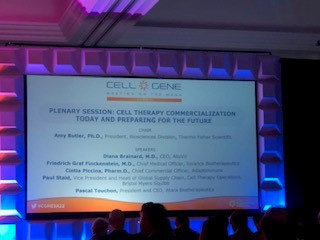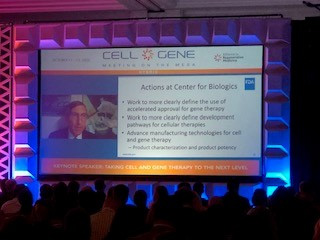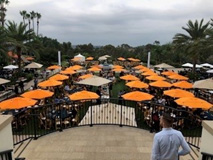Meeting On The Mesa 2022: Big Pictures & Takeaways

By Erin Harris, Editor-In-Chief, Cell & Gene
Follow Me On Twitter @ErinHarris_1
Alliance for Regenerative Medicine (ARM)’s Meeting on the Mesa (MOTM) 2022 was held October 11-13, 2022 in Carlsbad, CA. The meeting was packed with good information, and I wanted to share with you just a few of the most important soundbites I gleaned from the event. So, whether you attended the event in person, or you want to know what you may have missed, here are some of the highlights from MOTM 2022.
“Doing New Things Is Hard”

One of the central themes carried throughout MOTM 2022 via sidebar discussions and session topics was that doing new things is hard especially when it comes to the field of cell and gene therapy. For a space that is evolving exponentially, much of what we do is still so new. Drug development is hard. Manufacturing is hard. Regulatory compliance is hard. Why? Because it’s unprecedented – all of it. For example, the panelists for the Plenary session, “Cell Therapy Commercialization Today and Preparing for the Future,” echoed that sentiment throughout, but panelist Diana Brainard, CEO at AlloVir, shared a tone of optimism. “Many of us are working on moving into other types of tumors and treating other diseases outside of malignancies. And while not represented on this panel, we're getting into autoimmune diseases. The potential of cell therapy, particularly with an allogeneic approach, is now almost limitless.”
The Big Picture: As an industry, we are seeing that there are more programs in phase two and phase three coming to market than ever before. It certainly suggests a certain level of maturation in the cell therapy industry. To really mature in cell therapy specifically, we need to figure out how to drive efficiency and scalability into manufacturing and the supply chain. And, as many industry leaders proclaimed throughout MOTM, we will progress, but it takes time, money, iterations, and solid science.
Speaking of Time and Money …
With safety and efficacy as table stakes, in a perfect world, therapies would move quicker and more cost efficiently to commercialization. But the market has left the investor community leery about partnership. And depending on the main-stage panelist during The Current State of Investment in Cell and Gene Therapy main-stage session moderated by Pfizer’s Bob Smith, panelists’ tones were either downright blunt in their delivery of the news or optimistic that things will eventually turn around. Panelists explained, “Look for the investors who are going to be with you long term, have deep pockets, and who will be with you for the next two or three rounds. Also, syndication is important early on.”
The Big Picture: It’s about reducing COGS, process development standards, and creating a reliable, high-quality infrastructure. Easier said than done, but doing these things well could lead to investors who will know your company’s name.
GROW RegenMed Internship Program


Tim Hunt, ARM’s new CEO, took the stage to commence MOTM and again later to explain ARM’s GROW RegenMed Internship Program. In the spring of 2020, encouraged by member CEOs, ARM established the Action for Equality (AFE) Task Force to determine concrete steps ARM and its members could take to ally with the movement for racial equality and address the underrepresentation of Black employees within the regenerative medicine workforce. Led by Director Rosie Walker, GROW has more than 15 interns working side-by-side with various CGT companies. Walker was an expert panelist on our Cell & Gene Live, “Win the CGT Talent Fight: How to Find and Retain Experts,” during which she explains the benefits of GROW in detail. It’s well worth your time to tune in.
The Takeaway: GROW is an exceptional program that partners students studying various disciplines with cell and gene therapy companies to help advance tomorrow’s leaders. Consider hosting an intern from ARM’s GROW program. For more information, visit Alliance For Regenerative Medicine.
“The Agency”

Peter Marks, M.D., Ph.D., director of the Center for Biologics Evaluation and Research (CBER) at the FDA delivered his presentation virtually to a packed house. Dr. Marks covered gene therapy extensively and addressed on-going challenges. “The problem is the very small-scale area where we must find a way towards the personal viability. If we're going to succeed, we must figure out what's going to get us there. Some would argue that this is just something that should be handled by nonprofit groups. But I would argue that we're not going to find enough philanthropic groups to foot the bill for these gene therapies for the hundreds upon hundreds of different diseases that need to be addressed. We're going to have to find a way to make this commercially viable. One way of getting there may be to change how we think about making these things. It turns out that for certain things like AAV production, you can automate a fair amount, and we are in the process of working with various collaborators to see how much of this can be automated. This is made possible by any number of things including the fact that we now have various sensing technologists who put the right controls in place into systems.”
Dr. Marks went on to state that FDA is looking at how it can use its regulations to allow the agency to leverage its non-commercial manufacturing data from one application to another. “So initially, we'd start with allowing an individual company to leverage the information from one application to another, and then at some point if that's really working well, we can consider expanding that concept further. The idea here is that there were certain pieces of gene therapies that are not like your typical small molecule drugs.”
The Big Picture: You’re probably aware that there has been a reorganization of the institutions, and that this will advance every sense of the office therapeutic products. Dr. Marks stated there will be an office devoted to manufacturing gene therapies, an office devoted to the manufacturing of cell therapies, as well as a large clinical branch that will be able to employ people where they are needed. Change is coming, and that’s a good thing.
The Miscellaneous of MOTM

- I listened to a health and wellness podcast that touted, “Move a muscle, change a thought. Add fresh air, and you’re setting yourself up for success.” And so it goes with MOTM’s Park Aviara Resort location, which delivers the indoor/outdoor atmosphere that Northeasterners, especially, really appreciate. Being able to move freely from indoor sessions to conversations, meetings, and meals outdoors makes for a very enjoyable experience with which traditional convention centers just can’t compete.
- MOTM knows how to throw a party. Their Networking Bash earned its title - heavy on the fun and even heavier on the networking.
- Throughout my career, I’ve covered industries that are home to big egos. Not in the cell and gene sector, and certainly not at MOTM. Everyone in attendance, regardless of title, wanted to learn and better understand what you are doing in the space and why, as the focus is on the patient. How refreshing.
Did you attend MOTM 2022? Email me directly with your learnings, takeaways, and thoughts on the overall experience. I’m already looking forward to next year’s event.
